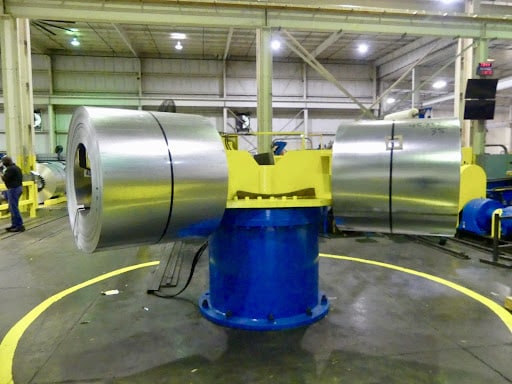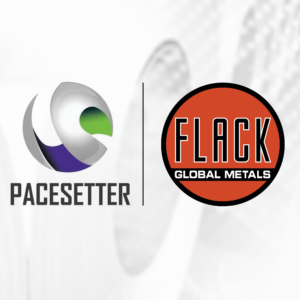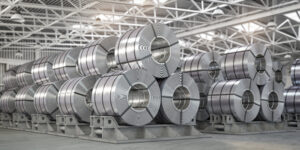Stainless Steel FAQs Part 2
Interested in all there is to know about stainless steel? You’re in the right place. This metal alloy composed of carbon, chromium, and nickel is a corrosion-resistant miracle material. No wonder it’s used in everything from buildings to artwork.
Before we get into these stainless steel FAQs, check out part 1 here.
Can You Blue Stainless Steel
Yes, you can blue stainless steel. Blueing is a controlled oxidation process. Essentially, it’s a way of methodically rusting steel to achieve a blue-black appearance.
While blueing is typically used for aesthetic purposes, it does provide protection against corrosion.
Learn about embossing, another aesthetic choice for steel.
Is Stainless Steel A Compound
Stainless steel is not a compound. Stainless steel is an iron-based alloy. This means it’s a combination of one metal with other metals.
Stainless steel is made of carbon, chromium, and other elements like nickel. The chromium (above a certain percentage) is what makes steel stainless.
Did you know there’s more than 1 type of steel? Find out more.
Can You Weld Stainless Steel
Yes, you can weld stainless steel. This metal is an excellent choice for welding because of its durability and corrosion resistance.
There are three common types of welding processes for stainless steel:
- TIG (Tungsten Inert Gas) welding: using two rods, an arc is made between a base metal and a non-melting electrode. Their meeting point is where the weld pool forms.
- MIG (Metal Inert Gas): An arc is made to fuse the metals using a wire to create a constant spark
- Spot: electrodes and heat from pressing two metals together create the fusion.
Related: Benefits of bonderized steel.
How To Cut Stainless Steel Sheet
What makes stainless steel such a valuable tool is strength and durability (which is also why it’s difficult to cut). But with the right tools and an expert on hand, cutting stainless sheets is possible.
The right tools to cut stainless steel sheets include:
- Shears
- Grinders
- Saws
- Cutters
The one you choose depends on the thickness of your steel sheet. From there, the process is straightforward, measure, mark, and carefully cut.
Shears and cutters are the safer methods to cut steel since you’re fully in control of the process. But for cutting in bulk, these tools may not be time-efficient.
Motorized grinders and saws cut quickly but with more risk. Be sure your tool reaches max RPM before cutting and moving steadily.
Safety masks, gloves, and aprons are must-haves to protect yourself and others.
Learn more: What’s cold-rolled steel?
How To Paint Stainless Steel
Stainless steel requires special paint to adhere to the material properly. So your typical paint can from Home Depot won’t work. But there are manufacturer-grade options available to prime, paint, and seal. Talk with your steel supplier for recommendations.
Once you’ve got the paint, it’s time to sand the stainless steel to create a rough surface for the paint. Then, clean the surface with ammonia or water-based solution and degreaser.
After that, prime and paint as you normally would. Just like painting a wall, you can use paintbrushes, rollers, or sponges to create the right texture. Finish with a sealer, and you’re done!
Related: Another aesthetic choice – perforated steel
An easier alternative is to buy prepainted steel: metal that’s been cleaned, treated, painted, and cured to corrosion-resistant durability. Its customizable colors and surfaces offer businesses a wide range of options to suit their needs.
Prepainted steel is cost-effective, low effort, customizable, and environmentally friendly.
More on prepainted steel here: https://teampacesetter.com/blog/prepainted-steel/
How Much Is Stainless Steel Worth
Stainless steel, even as scrap, is valuable for three reasons. It’s strong, durable, and recyclable. This means it can be used for a long time and many times over while retaining its integrity.
To find the real moneymakers, use these tricks.
- Magnets: many stainless steel grades are highly magnetic
- Weights: stainless steel is much heavier than other metals, like aluminum
- Rust: stainless steel is highly rust resistant
What is aluminized steel? Find out.
What Is Passivation Of Stainless Steel
Passivation is the process of using nitric or citric to remove iron from stainless steel’s surface. By removing iron, the stainless steel resists rust better.
Applied during the post-fabrication stage, passivation is an intelligent choice to improve the performance of a stainless steel product.
Learn about your options for steel fabrication.
Passivation also means less maintenance and a longer product shelf-life by preventing rust.
Does Stainless Steel Contain Nickel
Yes, stainless steel contains nickel. This may be surprising to those with nickel allergies. But with high-quality stainless steel, the nickel is so tightly wound it’s almost imperceptible to the skin.
Note, that the stainless steel must be high quality. Look for grading marks of 316L or 304. These levels are the best choice for hypoallergenic products like jewelry.
Related: Benefits of galvanized steel.
Does Stainless Steel Rust In Water
Yes, stainless steel rusts in water. While stainless steel is highly rust-resistant, it will corrode like any other metal under the right conditions.
These conditions can include:
- High chloride levels like the ocean
- High chlorine levels like pools
- Extreme temperatures
- Welding stainless steel with a different steel alloy
However, you can maintain stainless steel for years to come with the proper care. Make sure to remove rust as soon as it appears, clean the surface thoroughly, and apply a rust-resistant coating.
Related: Benefits of galvannealed steel
How To Restore Stainless Steel
To restore stainless steel, spray the surface with a vinegar-mineral oil mixture, and wipe with a soft cloth to remove surface dirt and smudges.
If dirt, grime, or stains remain, sprinkle baking soda or another nonabrasive scrub cleaner on a soft, damp cleaning cloth. Gently rub problem areas, going with the stainless steel grain until the area is clean. Spray the surface with vinegar-water mixture or glass cleaner and wipe again.
If further treatment is needed for tough stains or grime, apply a mild abrasive cleaner and scrub gently with a synthetic scrub pad along the stainless steel grain. Follow with a vinegar-water mixture or glass cleaner spray and wipe again.
Over time, stainless steel will need to be restored. Here’s how to do it properly:
- Spray the surface with a vinegar-based cleaner.
- Use a soft cloth or non-abrasive scrubber to rub the metal gently
- Wipe clean
If the stainless steel needs something stronger, combine the cleaner with baking soda. Always scrub with the grain!
Get A Quote Today
If you need stainless steel for your next project, contact our experts today. We’ll discuss your project needs and provide you with the best quote for our stainless steel products. We offer a variety of steel processing services, including slitting, blanking, cut-to-length, and toll processing services. And we emboss, prepaint, or fabricate steel to your exact specifications. Pacesetter is your steel expert.




